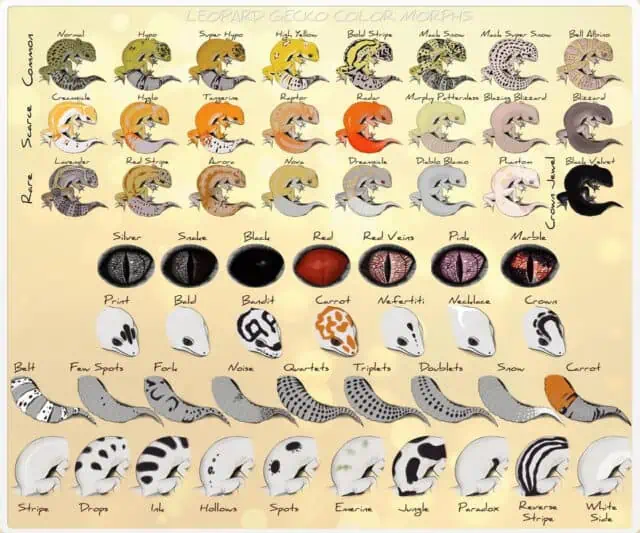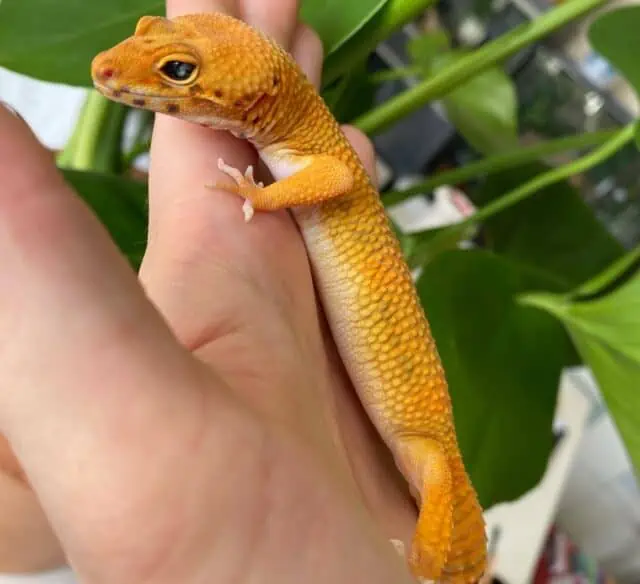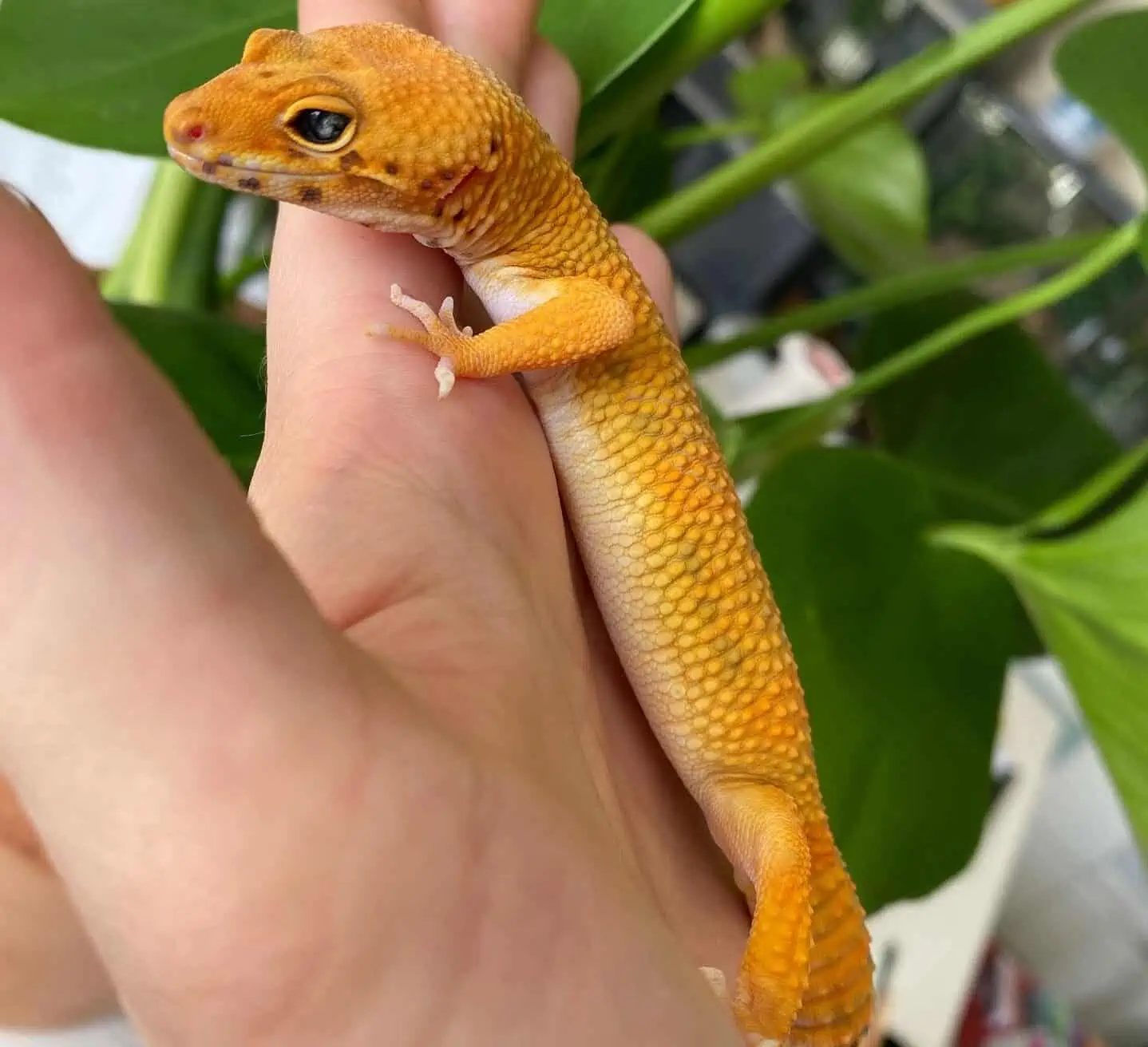Leopard Geckos, scientific name Eublepharis macularius, are among the most popular pet reptiles in the world, cherished for their gentle nature, longevity, and fascinating variety of appearances. These friendly lizards are native to the arid regions of Asia and have charmed their way into the hearts of many reptile enthusiasts. What sets them apart from many other reptile species is the sheer diversity of their appearance, made possible through the leopard gecko morphs.

But what are morphs, and what makes them so exciting in the world of Leopard Geckos? Strap in as we delve deep into the colorful and captivating world of Leopard Gecko morphs, an adventure of genetics, care considerations, and a palette of Leopard Gecko looks.
Whether you’re a seasoned breeder or just someone interested in these adorable creatures, there’s always something new to learn and marvel at in this space.
Leopard Gecko Morphs – What Are They
In the simplest of terms, a morph is a genetic variant of an animal that results in a distinct physical difference from the typical appearance of the species. This difference can be anything from a change in color or pattern to a drastic alteration in body shape or size.
When it comes to reptiles, especially Leopard Geckos, morphs become particularly fascinating. This is due to the wide range of unique physical attributes that these creatures can exhibit. They’re not only about appealing aesthetics, but they also provide valuable insights into the genetics of these creatures.
So, how do morphs come into being? It’s all about genetics. Genes are segments of DNA that act as instructions for building an organism. They are passed down from parent to child, resulting in inherited traits. In Leopard Geckos, specific genes control the color and pattern of their skin. Therefore, when geckos with different genes mate, their offspring may express unique combinations of these traits, resulting in a new morph.
There are dominant, recessive, and co-dominant genes involved in the formation of morphs. Dominant genes express their trait even when only one parent passes them down. Recessive genes need to be passed down from both parents to manifest, while co-dominant genes result in a blend of the parents’ traits. Understanding these gene interactions is the key to comprehending and predicting Leopard Gecko morphs.
Interestingly, the variation in Leopard Gecko morphs is not just about colors and patterns. Some morphs also impact the gecko’s eyes, like the Eclipse morph, which gives the gecko solid black eyes. Others affect body structure, such as the Giant morph, leading to geckos significantly larger than the average.
This genetic cocktail of possibilities has led to a plethora of visually stunning and genetically diverse Leopard Gecko morphs, which we’ll explore in the next section. Remember, each morph is more than just a pretty face; it’s a testament to the intricate and fascinating world of genetics.
Types of Leopard Gecko Morphs
Leopard geckos offer a dazzling array of morphs, each with its unique charm. Here’s a closer look at some of the most well-known Leopard Gecko morphs:
Normal Wild-Type Morph: This is the most common morph, displaying the natural coloration and patterning of leopard geckos in the wild. It typically includes a yellow base color with dark brown spots or bands.
High Yellow Morph: This morph has an amplified yellow base color compared to the wild-type morph. The dark brown spots are often fewer, leading to a brighter, more yellow appearance overall.
Tangerine Morph: Characterized by orange or red hues instead of the usual yellow, the Tangerine morph varies in intensity from light orange to a deep, vibrant red.

Blazing Blizzard Morph: This morph is a combination of the Blizzard and Albino morphs, resulting in a gecko with a creamy white body and striking red eyes.
Tremper Albino Morph: Named after Ron Tremper, who first bred this morph, Tremper Albinos lack melanin, which results in a lack of black pigment. They come in shades of yellow, pink, and white, and often have light-colored eyes.
Enigma Morph: This morph is known for its unique irregular patterning and often, strikingly colored eyes. However, it’s important to note that this morph is associated with a neurological disorder known as Enigma Syndrome.
RAPTOR Morph: Standing for Red-eyed Albino Patternless Tremper Orange, RAPTOR morphs are albinos with patternless bodies and, as the name suggests, red eyes.
Jungle Morph: Jungle morphs are identified by their irregular, disruptive patterning, as opposed to the usual bands or spots seen in other morphs. The base color and pattern colors can vary widely.
Rainwater Albino Morph: Also known as Las Vegas Albino, this morph is similar to the Tremper Albino but was discovered independently by Tim Rainwater.
Mack Snow Morph: This morph has a reduced yellow pigment, resulting in a black and white appearance during the juvenile stage that often transitions to a light yellow and black pattern as the gecko matures.
Carrot Tail Morph: The carrot tail leopard gecko is distinguished by its vibrant orange tail, which can cover up to 15% of its tail length.
Black Pearl Morph: A true black leopard gecko, this morph is currently one of the holy grails in leopard gecko breeding. It’s known for its near-black coloration that’s a result of selective breeding.
Patternless Morph: This morph is exactly what its name implies: a leopard gecko without the typical spots or bands. They are usually a uniform lavender color and may become more yellow with age.
Blizzard Morph: The name “Blizzard” aptly describes its snow-like appearance, making it a favorite among breeders and enthusiasts.
Giant Leopard Gecko Morph: These are the largest morphs of the Leopard Gecko, with the record-holder being weighed at 156 grams.
Lemon Frost Leopard Gecko Morph: One of the more controversial morphs available right now, thanks to the cancer issues that it has.
Red Stripe Leopard Gecko Morph: It gets its name from the special red stripes it has along its body. These geckos are orange or yellow, and they have two red stripes that go along their backs.
Radar Leopard Gecko Morph: These geckos are a blend of different looks and traits. The Bell Albino brings in cool colors, and the Eclipse adds unique eye patterns.
Sunglow Leopard Gecko Morph: These geckos stand out with their unique and radiant coloration, a mesmerizing mix of sunny yellows, soft oranges, and sometimes even pale pinks, with a lack of the typical dark spots.
Super Hypo Leopard Gecko Morph: A Super Hypo Leopard Gecko is a morph of the leopard gecko, one of many available. It’s known for having no spots on its body.
Remember, this is not an exhaustive list. New morphs are being discovered and bred all the time, adding to the fascinating diversity of this species. Some are rare leopard gecko morphs, others much more common.
Breeding Leopard Gecko Morphs
Breeding Leopard Gecko morphs is a fascinating endeavor. It allows breeders and hobbyists alike to dive deep into the rich genetic world of these charming creatures. However, it also requires a sound understanding of reptile genetics to predict possible outcomes and to breed responsibly.
Every Leopard Gecko carries two copies of each gene – one from the mother and one from the father. Depending on whether these genes are dominant, recessive, or co-dominant, the offspring will display different traits.
For instance, two high-yellow Leopard Geckos can produce an offspring with an even more pronounced yellow coloration. But what happens when you breed two different morphs together?
Breeding different morphs can result in a variety of outcomes. For example, if you breed a Mack Snow Leopard Gecko with a Normal one, about half of the offspring will be Mack Snows (assuming the Normal doesn’t carry the Mack Snow gene).
However, if both parents are Mack Snow, all the offspring will carry this trait, with a quarter of them becoming Super Snow, a variant with an even more pronounced reduction in yellow pigment.
While breeding different morphs can be exciting, it also comes with certain risks and ethical considerations. For example, breeding two Enigma morphs can result in offspring with a higher risk of Enigma Syndrome, a neurological condition that affects a gecko’s balance and coordination. To prevent this, responsible breeders avoid breeding two Enigmas together.
Further, ethical considerations come into play when considering the health and well-being of the produced offspring. It’s essential to avoid inbreeding or breeding animals with known health issues.
Also, due to the potential for unexpected or undesirable traits to emerge, breeders should be prepared to provide lifelong care to any geckos they breed, if necessary.
In conclusion, breeding Leopard Gecko morphs opens a world of exciting possibilities, but it’s not to be taken lightly. It requires careful planning, a solid understanding of genetics, and a commitment to the well-being of the geckos involved.
With these elements in place, breeding these fascinating creatures can be an incredibly rewarding experience.
Caring for Different Leopard Gecko Morphs
Irrespective of their morph, Leopard Geckos share similar basic needs when it comes to care. This includes a suitably warm and dry environment, a diet rich in nutrition, adequate hydration, and safe, comfortable housing. However, certain morphs may have specific needs or considerations, particularly if they are associated with particular health conditions.
Heat and Light
Leopard Geckos, across all morphs, are ectothermic, which means they rely on their environment to regulate their body temperature. They need a heat source in their enclosure to help them digest food and stay healthy. However, unlike many other reptiles, they do not require UVB light to produce vitamin D3, as they can ingest it from their diet.
Diet
All Leopard Geckos are insectivores, and their diet should consist primarily of insects such as crickets, mealworms, and waxworms. Some morphs, like the Giant, may require more food due to their larger size.
Hydration
Fresh water should always be available for your Leopard Gecko. It’s also beneficial to mist the enclosure occasionally, as some geckos prefer to lick water droplets from their surroundings.
Housing
Leopard Geckos of all morphs require a secure enclosure with plenty of hiding places. A substrate of paper or tile is preferred to prevent impaction issues associated with loose substrates.
While these basic care guidelines apply to all Leopard Geckos, certain morphs have additional considerations. For example, Albino morphs (like the Tremper and Rainwater Albinos) are particularly sensitive to light due to their lack of melanin. These geckos may require lower light levels than other morphs to prevent discomfort.
Similarly, Enigma morphs may require special care due to Enigma Syndrome. Affected geckos can have problems with balance and coordination, so their environment needs to be safe and easy to navigate. Reducing stress is also vital for these geckos, so handling should be kept to a minimum.
Conclusion
The world of Leopard Gecko morphs is truly a wonder to behold. These little creatures, with their variety of colors, patterns, and sizes, showcase the marvel of genetic diversity in nature. From the classic Wild-Type to the intriguing Enigma, each morph brings its own charm and fascination.
However, as we’ve seen, understanding and caring for these unique creatures requires more than just an appreciation of their beauty. It demands a deeper understanding of their genetics, special care considerations, and responsible breeding practices. But therein lies the joy of engaging with these captivating reptiles.
It’s not just about the visual appeal; it’s about immersing oneself in their world, understanding their unique traits, and providing them with the care they deserve.
Whether you’re a hobbyist, an aspiring breeder, or just someone who loves these adorable lizards, the world of Leopard Gecko morphs offers endless opportunities for exploration and enjoyment.
So go ahead, delve deeper, and lose yourself in the colorful and fascinating world of Leopard Gecko morphs. You’ll be amazed at what you discover.
FAQs
What is a Leopard Gecko morph?
A Leopard Gecko morph refers to a genetic variant of the Leopard Gecko that leads to a distinct physical appearance from the typical or wild-type appearance of the species. This can involve changes in color, pattern, or even body structure.
How many Leopard Gecko morphs are there?
There are numerous Leopard Gecko morphs, with new ones continually being discovered as breeders experiment with different genetic combinations. Some of the most well-known include the Normal Wild-Type, High Yellow, Tangerine, Blazing Blizzard, Tremper Albino, Enigma, RAPTOR, Jungle, Rainwater Albino, Mack Snow, Black Pearl, and Patternless.
Can different Leopard Gecko morphs live together?
In general, Leopard Geckos are solitary animals and do best when housed individually. Housing them together, even if they’re of the same morph, can lead to stress, competition for resources, and even fighting.
Do different Leopard Gecko morphs require different care?
While the basic care needs of Leopard Geckos are consistent across all morphs, some morphs may have specific care requirements or considerations. For example, Albino morphs are particularly sensitive to light and may require lower light levels than other morphs.
Is it ethical to breed Leopard Gecko morphs?
Breeding Leopard Gecko morphs can be done ethically, but it requires a solid understanding of genetics and a commitment to the well-being of the animals. Breeding should always prioritize health over aesthetic appeal, and breeders must avoid inbreeding or breeding animals with known health issues.





